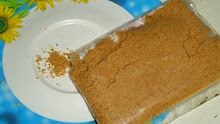 |
| Ginger Plant with Flower |
Ginger or ginger root is the rhizome of the plant Zingiber officinale, consumed as a delicacy, medicine, or spice. It lends its name to its genus and family (Zingiberaceae). Other notable members of this plant family are turmeric, cardamom, and galangal. The distantly related dicots in the Asarum genus have the common name wild ginger because of their similar taste.
Ginger is indigenous to southern China, from whence it spread to the Spice Islands and other parts of Asia, and subsequently to West Africa and the Caribbean. Ginger appeared in Europe, via India, in the first century AD as a result of the lucrative spice trade.
Ginger produces clusters of white and pink flower buds that bloom into yellow flowers. Because of its aesthetic appeal and the adaptation of the plant to warm climates, ginger is often used as landscaping around subtropical homes. It is a perennial reed-like plant with annual leafy stems, about a 3 to 4 feet tall. Traditionally, the rhizome is gathered when the stalk withers; it is immediately scalded, or washed and scraped, to kill it and prevent sprouting. The fragrant perisperm of Zingiberaceae is used as sweetmeats by Bantu, also as a condiment and sialogogue.
Ginger produces a hot, fragrant kitchen spice. Young ginger rhizomes are juicy and fleshy with a very mild taste. They are often pickled in vinegar or sherry as a snack or just cooked as an ingredient in many dishes. They can also be steeped in boiling water to make ginger tea, to which honey is often added; sliced orange or lemon fruit may also be added. Ginger can also be made into candy, or ginger wine which has been made commercially since 1740.
Mature ginger rhizomes are fibrous and nearly dry. The juice from old ginger roots is extremely potent and is often used as a spice in Indian recipes, and is a quintessential ingredient of Chinese, Korean, Japanese, Vietnamese and many South Asian cuisines for flavoring dishes such as seafood or goat meat and vegetarian cuisine.
Ginger acts as a useful food preservative.
Fresh ginger can be substituted for ground ginger at a ratio of 6 to 1, although the flavors of fresh and dried ginger are somewhat different. Powdered dry ginger root is typically used as a flavoring for recipes such as gingerbread, cookies, crackers and cakes, ginger ale, and ginger beer.
Candied ginger, or crystallized ginger, is the root cooked in sugar until soft, and is a type of confectionery.
Fresh ginger may be peeled before eating. For longer-term storage, the ginger can be placed in a plastic bag and refrigerated or frozen.
In Western cuisine, ginger is traditionally used mainly in sweet foods such as ginger ale, gingerbread, ginger snaps, parkin, ginger biscuits and speculaas. A ginger-flavored liqueur called Canton is produced in Jarnac, France. Ginger wine is a ginger-flavored wine produced in the United Kingdom, traditionally sold in a green glass bottle. Ginger is also used as a spice added to hot coffee and tea.
 | |
| A packet of ginger powder |
In limited studies, ginger was found to be more effective than placebo for treating nausea caused by seasickness, morning sickness and chemotherapy, although ginger was not found superior to placebo for pre-emptively treating post-operative nausea. Some studies advise against taking ginger during pregnancy, suggesting that ginger is mutagenic, though some other studies have reported antimutagenic effects. Other preliminary studies showed that ginger may affect arthritis pain or have blood thinning and cholesterol lowering properties, but these effects remain unconfirmed.
A 2013 in vivo evaluation demonstrated ginger extract showed a hepatoprotective effect in rats. A 2013 review found that ginger is a free radical scavenger, antioxidant; thus inhibits lipid peroxidation and that these attributes could be contributing to its known gastroprotective effects. A 2012 review found ginger extract and ginger juice possess anti-emetic effects against chemotherapy-induced nausea and vomiting in experimental animals. A 2012 review found the radioprotective properties of ginger extract might be effective to protect against gamma radiation-induced side effects from cancer treatment in mice. A 2011 review found ginger displays chemopreventive and antineoplastic effects. The same review found that ginger appears to be promising for cancer prevention, though further research is necessary to evaluate the efficacy and safety of ginger. Advanced glycation end-products are possibly associated in the development of diabetic cataract for which ginger was effective in preliminary studies, apparently by acting through antiglycating mechanisms. Zingerone may have activity against enterotoxigenic Escherichia coli in enterotoxin-induced diarrhea in mice.
Tips for Preparing Ginger
To remove the skin from fresh mature ginger, peel with a paring knife. The ginger can then be sliced, minced or julienned. The taste that ginger imparts to a dish depends upon when it is added during the cooking process. Added at the beginning, it will lend a subtler flavor while added near the end, it will deliver a more pungent taste.
A Few Quick Serving Ideas
* Turn up the heat while cooling off by making ginger lemonade. Simply combine freshly grated ginger, lemon juice, cane juice or honey and water.
* Add extra inspiration to your rice side dishes by sprinkling grated ginger, sesame seeds and nori strips on top.
* Combine ginger, soy sauce, olive oil and garlic to make a wonderful salad dressing.
* Add ginger and orange juice to puréed sweet potatoes.
* Add grated ginger to your favorite stuffing for baked apples.
* Spice up your healthy sautéed vegetables by adding freshly minced ginger.
No comments:
Post a Comment